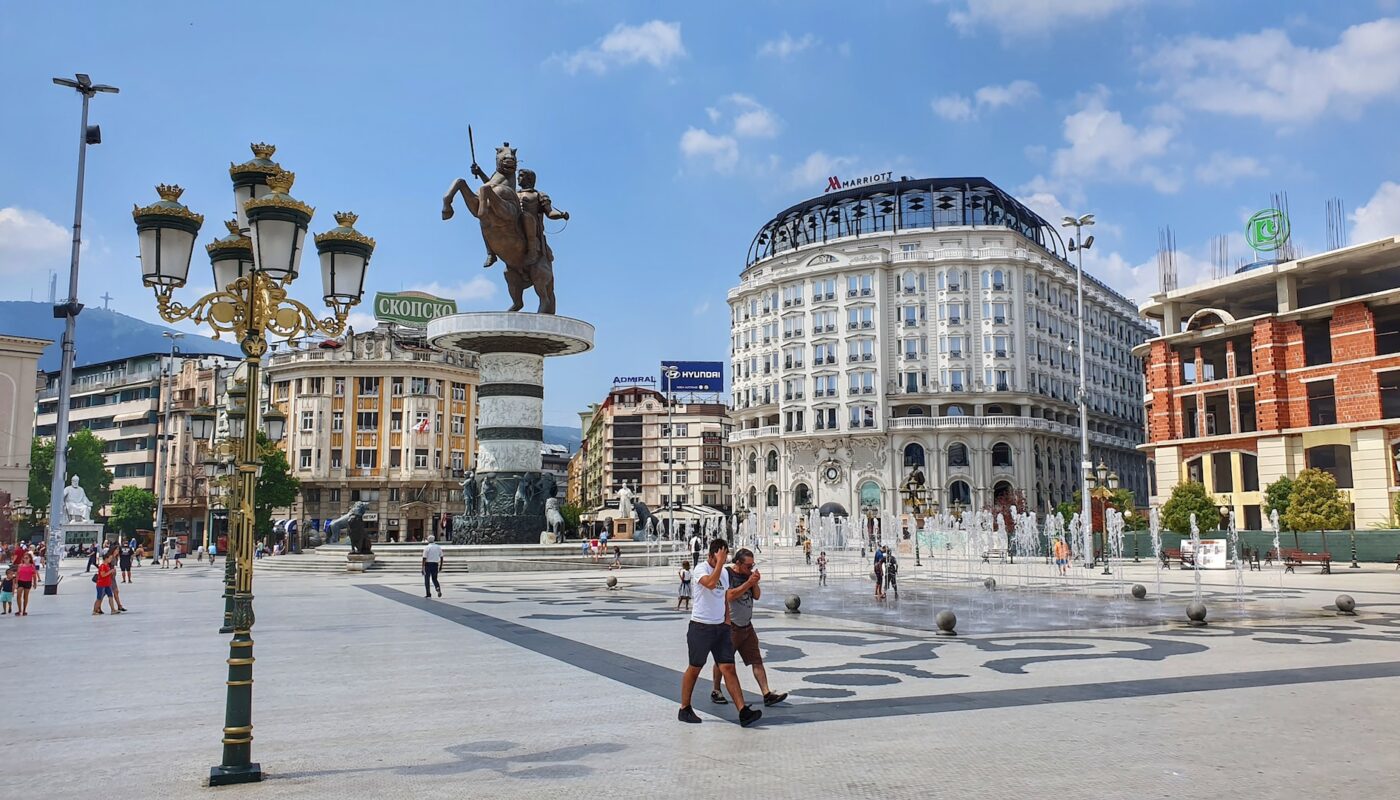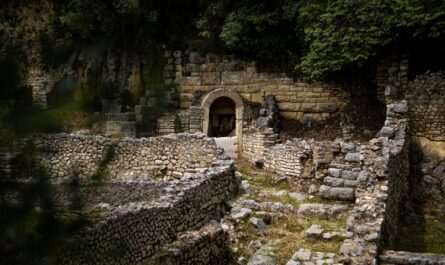Nestled in the heart of the Balkans, Skopje, the capital of North Macedonia, is a city that boasts a unique charm—where the ancient and the modern seamlessly coexist. What sets Skopje apart from other European cities is its fascinating collection of statues that dot the landscape, turning the streets into an open-air museum. Join us on a journey as we explore Skopje, a city that proudly wears its history and culture in the form of majestic statues.
The Stone Sentinels of Skopje
Skopje’s city center is an eclectic mix of architectural styles and historical periods, with each statue telling a story of the city’s rich past. From the imposing figure of Alexander the Great on horseback to the contemplative Mother Teresa, the statues in Skopje serve as guardians of the city’s heritage. These stone sentinels not only beautify the city but also offer a unique glimpse into the historical and cultural tapestry of the region.
Bridge of Civilizations
One of the most iconic landmarks in Skopje is the Stone Bridge, a crossing that spans the Vardar River. Guarding this historic bridge are numerous statues, each representing a different facet of Macedonian history. The Warrior on a Horse, the Ottoman-era figure of Isak Bey, and the modern sculptures of Macedonian revolutionaries—these statues create a bridge of civilizations, connecting the city’s past to its present.
The Artistic Revolution
In 2014, Skopje underwent a radical transformation with the implementation of the “Skopje 2014” project, an initiative aimed at giving the city a new, monumental identity. The project added a plethora of statues, fountains, and neoclassical buildings, sparking both admiration and controversy. The colossal statues of historical figures and mythological creatures symbolize the city’s desire to embrace its rich history while looking towards the future.
A Tribute to Mother Teresa
Skopje takes pride in being the birthplace of Mother Teresa, and the city has dedicated a significant portion of its public spaces to honor her legacy. The Mother Teresa Memorial House, a modern architectural marvel, stands as a tribute to her life and humanitarian work. The nearby statue captures her essence, radiating compassion and humility, making it a must-visit for those seeking inspiration.
Beyond the City Center
While the city center is a treasure trove of statues, Skopje’s artistic spirit extends beyond this area. As you explore the neighborhoods and parks, you’ll encounter hidden gems—statues that celebrate local heroes, artists, and everyday life. From the expressive sculptures in the City Park to the playful statues in the Children’s Zoo, every corner of Skopje is adorned with artistic expressions.
A Symphony of Styles
Skopje’s statue collection is not confined to a single artistic style or historical period. The city’s diverse sculptures reflect a symphony of styles, from classical and neoclassical to modern and abstract. This amalgamation of artistic expressions showcases the city’s openness to evolution while preserving its roots. The contrast between the timeless sculptures of ancient warriors and the contemporary, avant-garde pieces creates a dynamic visual narrative that captivates visitors.
Nightfall Magic
As the sun sets, Skopje’s statues come to life in a different light—literally. The city is transformed into a magical realm as the statues are gracefully illuminated. The soft glow accentuates the details of each sculpture, casting a romantic ambiance over the city. A nighttime stroll along the riverside or through Macedonia Square provides a unique perspective, allowing visitors to appreciate the statues in a different, enchanting context.
Interactive Art
Skopje encourages a hands-on experience with its statues. Unlike traditional museums, where art is often kept behind glass barriers, here, visitors can interact with the sculptures. From posing for photos with the iconic figures to engaging in spontaneous performances around public art installations, Skopje’s statues invite a level of participation that fosters a deeper connection between the art and the community.
Unraveling Stories
Behind every statue in Skopje lies a captivating story waiting to be unraveled. Whether it’s the allegorical figures in the City Park or the intricate details of the “Warrior on a Horse,” each statue has a narrative that adds layers to Skopje’s cultural identity. Local guides often share these tales, providing visitors with a richer understanding of the historical events and cultural symbols depicted in the sculptures.
Cultural Festivals and Events
Skopje’s love affair with statues is celebrated annually through cultural festivals and events that showcase the city’s artistic prowess. The Skopje Statue Festival, for instance, brings together local and international sculptors, transforming the city into an open canvas. Visitors have the opportunity to witness live sculpting sessions, interact with artists, and gain insights into the creative process behind the statues that adorn Skopje’s streets.
Statues as Landmarks
Skopje’s statues serve not only as artistic expressions but also as practical landmarks, guiding both locals and tourists through the city. Locals might arrange to meet at the feet of a particular statue, turning these iconic landmarks into meeting points and social hubs. The statues become woven into the fabric of daily life, symbolizing not only the city’s history but also its present-day vibrancy.
Artistic Dialogues
The statues of Skopje often engage in a silent dialogue with the surrounding architecture, creating a dynamic interplay between the old and the new. Modern sculptures seamlessly integrate with historical buildings, challenging preconceived notions about urban aesthetics. This artistic dialogue reflects the city’s commitment to fostering a harmonious coexistence between tradition and innovation.
Community Involvement
Skopje’s statues are not merely the result of top-down artistic initiatives; they are often the product of community involvement. Local artists, inspired residents, and civic groups contribute to the creation and maintenance of public art. This communal engagement not only instills a sense of pride among residents but also ensures that the statues remain relevant and reflective of the city’s evolving identity.
Seasonal Transformations
Skopje’s statues undergo seasonal transformations, adding a dynamic dimension to the city’s visual landscape. During festivals and holidays, sculptures may be adorned with festive decorations or thematic lighting, creating a festive atmosphere. This adaptability and creativity ensure that the statues remain integral to the city’s cultural calendar, evolving with the seasons and reflecting the diverse moods of Skopje.
Cultural Diplomacy
Skopje’s statues also play a role in cultural diplomacy, serving as ambassadors that communicate the city’s identity to the world. The depictions of historical figures and cultural symbols send a powerful message about the city’s heritage and values. Tourists visiting Skopje often leave with not only memories of the statues but also a deeper understanding of the city’s cultural richness.
A Living Art Gallery
In essence, Skopje can be seen as a living art gallery, where the statues are not confined to the walls of a museum but are an integral part of the urban experience. The city’s commitment to public art, the interactive nature of the sculptures, and the ongoing dialogue between tradition and modernity make Skopje a destination where art is not just observed but lived.
Conclusion
Skopje’s status as a city of statues is a dynamic and evolving narrative, where each sculpture contributes to the vibrant tapestry of the city. Beyond their aesthetic appeal, the statues of Skopje embody the city’s history, resilience, and commitment to cultural expression. So, whether you’re wandering through the city center, attending a cultural festival, or simply enjoying a leisurely stroll along the Vardar River, let the statues of Skopje be your companions on a journey through time, art, and the enduring spirit of a city that proudly wears its history in bronze and stone.




